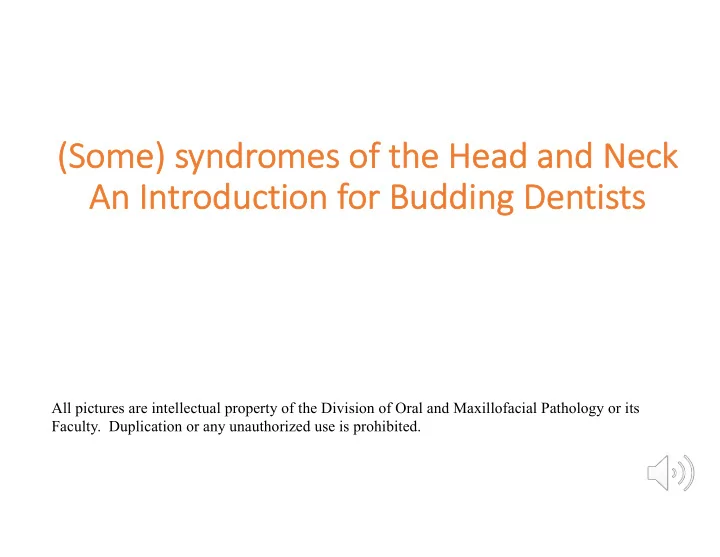

(S (Some) s ) syndromes o of t f the H Head a and N Neck An An Introduction for Budding Dentists All pictures are intellectual property of the Division of Oral and Maxillofacial Pathology or its Faculty. Duplication or any unauthorized use is prohibited.
Genetics is the study of inheritance and expression of inherited traits Syndrome is a distinctive association of signs and symptoms occurring together in one individual Inherited vs. Acquired (e.g. AIDS) Phenotype and genotype Phenotype: Visibly observable characteristics created by Genotype: Genetic characteristics that influences a phenotype
When the mandible is small…..
Pierre Robin Sequence (Pierre Robin Anomalad) 1. Mandibular micrognathia: Prevents descending of the tongue causing CP 2. Cleft palate: Wider and U-shaped than regular CP 3. Glossoptosis: Causing airway obstruction
(Pierre) Robin sequence (anomalad = bad term, don’t use it) • Micrognathia, cleft palate, glossoptosis • Catch-up growth can occur in mandible development by age 4-6 • Snail gene family may play some role • Can be part of many other conditions, Stickler syndrome (30% of Robin patients) • Underdeveloped midface, hearing loss, detachment of the retina, etc)
Cleft palate Hypoplasia of the mandible
Treacher Collins syndrome Mandibulofacial dysostosis • 1 st and 2 nd branchial arch, groove and pouch defects • Treacle • A.D., variable expressivity • There are cases that are very mild • Increased paternal age • Hypoplastic zygomas, mandible • Narrow face with depressed cheeks • Down-slanting palpebral fissures which are frequently asymmetric • Hearing defects; no ears, ear tags • Coloboma of outer portion of lower eyelid • No eyelashes medially
Treacher Collins syndrome Mandibulofacial dysostosis • Normal mentation • Oral findings • Cleft palate • Agenesis of the soft palate • Parotid glands may be absent or hypoplastic • Pharyngeal hypoplasia
When the maxilla is small….. The craniosynostoses
Craniosynostoses • Many types • Premature closing of cranial sutures • FGFR2 • A.D. but many cases are new mutations • Worst form: Kleeblattschädel (Cloverleaf skull) • Underdeveloped maxilla • Hypertelorism • Palatal soft tissue overgrowth may resemble cleft • Crouzon and Apert syndrome the most common
Crouzon syndrome • Underdeveloped maxilla • Midface hypoplasia • Midface hypoplasia • Crowding of maxillary teeth • Bifid uvula • Beaten metal radiograph • Surgical treatment
Apert syndrome • Acrobrachycephaly • Ocular proptosis; hypertelorism, beaten metal radiographs • Midface hypoplasia • High arched palate • Syndactyly of the 2 nd , 3 rd , and 4 th digits • Pseudo-cleft palate • Crowding of teeth • Bifid uvula
Beaten metal radiographic appearance of the skull
Pfeiffer syndrome • Craniosynostosis • AD but also sporadic cases • Three types with type 1 compatible with life • Broad thumbs • Broad great toes • Partial soft tissue syndactyly of the hands
But this person has so many teeth………
Cleidocranial Dysplasia Caused by a defect in Cbfa1(Runx2) Odontogenesis and osteoblast differentiation Reported in a Neaderdal skeleton Autosomal dominant and sporadic pattern Bone defects involve the clavicle and skull Clavicles are absent (unilateral or bilateral) – 10% of cases Short stature with large heads; ocular hypertelorism; broad base of nose and depressed nasal bridge Skull sutures show delayed closure and may remain open Oral manifestations include narrow, high-arched palate with increased prevalence of cleft palate
Cleidocranial Dysplasia Presence of numerous unerupted permanent and supernumerary teeth with many distorted crown and root shapes Prolonged retention of deciduous teeth and delay or complete failure of eruption of permanent teeth Histology: Unerupted permanent teeth lack cellular cementum Treatment: No treatment; full-mouth extractions with denture construction; removal of primary and supernumerary teeth followed by exposure and orthodontic treatment of permanent teeth
The gingivae are so thick…….
Gingival fibromatosis • Gingival hyperplasia can be associated with medications • Anticonvulsants • Calcium channel blockers • Cyclosporine • Erythromycin • Oral contraceptives • Gingival hyperplasia may be an isolated condition unrelated to medications • Gingival hyperplasia may part of a syndrome
Syndromes with gingival fibromatosis • Laband • Murray-Puretic-Drescher • Rutherford • Cross
Cowden syndrome
But most frequently such gums may be seen in patients on …. • Oral contraceptives • mestranol, norethindrone • Anticonvulsants • phenytoin • Immunosuppressants • cyclosporine A • Calcium channel blockers • nifedipine, verapamil, diltiazem
Recommend
More recommend